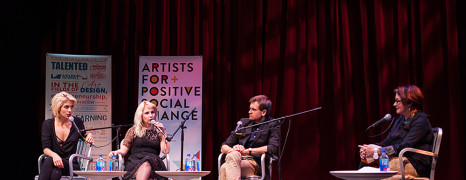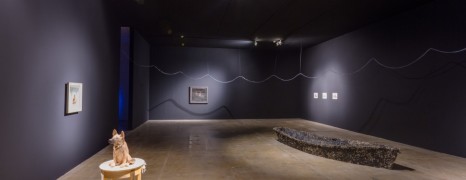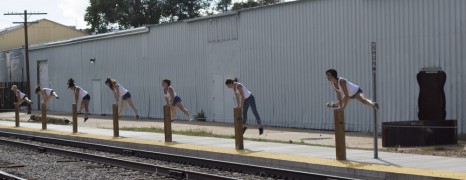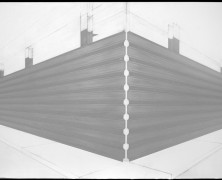Pussy Riot’s founding members speak to students, community about their art, activism and the nature of freedom.
SITE Scholars Ascend
posted by Brandon Ghigliotty
SITE Santa Fe honored a new crop of young artists during its 2013 SITE Scholars Awards Ceremony on Nov. 21. Honorees included students from SFUAD, Institute of American Indian Arts, St. John’s College, the University of New Mexico, and New Mexico Highlands University.
The Murk of Memory
posted by Brandon Ghigliotty
Enrique Martinez Celaya transformed nearly 12,000 feet of gallery space into an autobiographical journey at SITE Santa Fe. “The Pearl” spoke of loneliness, longing and and a troubled relationship to the landscape. Both through absence and explicitness, the work conjured the turmoil of memory. Pushing past the entryway of the installation, the gallery-goer confronts the image of a German Shepherd eating a house-shaped block of meat. Hideous baby laughter bleats out intermittently as the canine devours its meal from the plate. The image was projected on thick canvas blinds that concealed the next part of the journey. Once the canvas curtains hosting The Guardian are navigated, a small window appears on the left, giving a glimpse of the future experience ahead. The space opened up to 24 Casuarina pines leaning against the walls. Small nubs jutted from the tree trunks where the branches have been stripped off. The Forest (or The Others) borders an area enveloped with the cacophony of surging waves and tinkling piano music. A thin ribbon of tubing hung from the ceiling and served as a trail of breadcrumbs leading further into fantasy. A carved statuette of a German Shepherd, its neck betraying its role as a cookie jar, greeted visitors to the room that seeped piano music. The cookie jar’s table was relatively unmarred, with a diminutive ash-splotched unicorn attached to its side. The music, Martinez Celaya’s first composition, sprang from The Stone and the Air, a kitsch-littered old Zenith radio. Twelve porcelain songbirds rested on the radio and walnut shelf, reminiscent of a warm, distant memory. The Short Journey was a rowboat that rested at the center of the room, tarred and feathered, containing a glimmering, toppled lighthouse. Water, possibly taken on during its journey, pooled in the bottom of the rowboat. The Table, a charred dining set, brooded against The Ocean, a projected backdrop of black and white waves. At the center of the dining table was a bejeweled elephant, which, through stubbornness or ignorance, flaunted its opulence against the tragic setting and crashing waves. The tubing continued to an immense space occupied by two paintings staring at each other past a weeping, jewel-studded boy. The first painting, The Dock, depicted three swimwear-clad boys on a pier. The nearest boy looked down the pier at the pair of other boys, one squatting while the other returned the onlooker’s gaze. The painting projects sadness, alienation and longing, although a gallery attendant offered the interpretation that depicts Celaya at different points in his life. Reconciling the two reveals a composite characterization of Celaya’s loneliness. The Separate Cascade slouched at the center of the room, weeping into The Fountain, a pine needle-laden trough that narrowed and snaked out of sight. Moving through the impressive space created distance from the bawling child, a passage of time accentuated by the trickle of water. Then, The New Comer came into view. An uncertain young boy reached out to a smattering of flowers as a hummingbird watched on. “This is where I made my stand” was scrawled along the bottom of the scene. The trough ducked into a room that contained The North, a raw plywood house spewing stars through its roof. The night sky ceiling dripped into walls sprinkled with dozens of taxidermied cotton butterflies–petite cut-outs–interrupted by the sheets from which they were clipped, which gave the illusion of jet-black butterflies through the wounds. The butterfly-infested walls spilled out to a shining white room shrill with songbirds. The Better Place consisted of a labored machine gasping into a set of lungs that floated on a gleaming pond, while a stuffed fox stood amongst a pine tree setting taking in the scene. The asthmatic, desperate child that was Enrique Martinez Celaya brought the observer along with him on his journey through “The Pearl.” A journey through the stirred murk of memory. Photos by Eric Swanson, courtesy of SITE Santa Fe....
Art for Everyone
posted by Charlotte Martinez
They look at me as if they don’t understand. “What does Progressive Art mean to you?” I ask again. The two women smirk at one another. Maybe I’m missing something. They are the organizers of the Santa Fe Art Resource website, after all, the information booth for everything art in Santa Fe. One is Julie Ruth, an out-of-practice artist, and the other is Christy George, a sculptor who previously taught at SFUAD. They both sit at their booth, Sunday Sept. 15, during Santa Fe’s 3rd Annual AHA Festival of Progressive Arts, a community-sponsored event dedicated to its local artists. “If someone called me a progressive artist,” George begins, “I might want to slap them, but I’m not sure. I mean I am a progressive artist, but how do I feel about that?” They look at each other again. Ruth is fixing her shoe with duct tape. “Progressive in the sense that it’s designed to make progress,” George says. “It’s part of the community…that’s one of the problems with contemporary art these days, in that it exists in these sterile white wall environments and it’s intimidating.” “They’re taking art to everyone,” Ruth says. “Kids can interact with it…there’s something for everyone here.” She’s right. As families take in the booths of AHA Fest, the kids color on “sterile white walls,” run through installations as if they were monkey bars, and reach out to touch red-haired Rag and Tag, the clowns of Flying Wall Studios Puppet theater. Remember this? Playing? Garson Dance Company from SFUAD definitely has fun contributing to the progressive afternoon. Wearing white muscle shirts, jean shorts and black canvas shoes, the seven dance majors ease and speed their way through the Farmer’s Market side street and onto the train track sidewalk with some exciting train mimicry and smooth moves. “I’m tired,” freshman Stephanie Martinez says, after what is to be the first of many performances. “Half way through I was like ‘I need water!’ You wouldn’t think it’s tiring, but…” Martinez marks an extraneous kick and sticks her tongue out in exhaustion. Message received. Martinez explains that though she has done some experimental Summer intensives, she’s never done site-specific dance. “It was very different,” she says. Speaking of site-specific dance, I am drawn next to the gallery space at Site Santa Fe, across the street from the Farmer’s Market, where a mesmerizing collaboration with Arcos Dance company takes place. Camouflaged by grey walls and the dark shadows of Enrique Martinez Celaya’s art, these dancers ease, like drops of honey, from installation to installation until they all merge and break out in full body dancing. Their faces, never breaking character, stare off into the paintings hung on the wall or into the faces of the audience members, who can’t help but stare back. When I return to the main AHA Fest sidewalk, there is much more play occurring. I say play, because what else would you call young women screeching and screaming to unsteady and unpredictable noise other than play for adults? Helen Gruhlkey and her partner Vodi Grontis call it “Distortion by Design,” a mixture of environmental sounds and noise. In addition to soundboards and vintage music sheets, Gruhlkey’s installation exhibits photos of garbage and street litter. I ask about those. Gruhlkey explains that many of their sounds come from the large amounts of trash they pick up from their community and, if I’m not mistaken by the connection here, they hope to call attention to the waste problem by performing their “sounds” for the public. And it is quite the whaling sound. And “Distortion By Design” is not the only sound cascading through the side street of the farmer’s market. Anyone within three blocks of the Railyard can hear the hard rock rage from the band stand, which throughout the afternoon includes performances by Alamo Sun, Lady Gloves, Accordion Crimes, Lily Taylor, Jupiter Spiral, Evarusnik, Adam...
Art Infusion
posted by Brandon Ghigliotty
The Fall 2013 semester is bustling with events and the art department is no different. Three events draw near: faculty member Tom Miller’s exhibition at Zane Bennett Contemporary Art, Enrique Martinez Celaya’s lecture in Tipton Hall and hARvesT, the 2nd annual juried exhibition. Tom Miller’s exhibition, Walling: Containing Architecture, looks to challenge the role of barriers in society. Miller’s concern lead him to a body of work that navigates the notions of transition and perspective. The show features an installed wall centerpiece measuring 24 feet in length. Its front—a stark, neutral white—contrasts sharply with the worn back, which reveals supports reminiscent of tank traps. Miller was worried about being limited to painting when he entered graduate school. “With sculpture I could do anything,” said Miller. On Oct. 1, Enrique Martinez Celaya comes to campus for a lecture in Tipton Hall. Martinez Celaya, a Cuban American artist, is responsible for shaping nearly 12,000 feet of gallery space at SITE Santa Fe. According to Martinez Celaya’s biography, he was pursuing his doctorate in quantum physics before shifting his focus to the art he practiced in his spare time. Given the gestures of reclamation within Martinez Celaya SITE Santa Fe exhibition, it would be a great opportunity to ask questions such as, “I read something in your biography about laser patents. What the hell, man?” The lecture is a collaborative effort between SITE Santa Fe and Santa Fe University of Art and Design. Linda Swanson, chair of the art department, discussed the relationship between SITE Santa Fe and the university. Such as the opportunities afforded by internships and the benefit of having Joanne Lefrak, director of education and outreach, engaging with the students in the classroom. “I think of them as one of the institutions that expands...






 Jackalope Magazine is the student magazine of Santa Fe University of Art and Design. Building on the interdisciplinary nature of our education, we aim to showcase the talent of our university and character of our city.
Jackalope Magazine is the student magazine of Santa Fe University of Art and Design. Building on the interdisciplinary nature of our education, we aim to showcase the talent of our university and character of our city.
Recent Comments